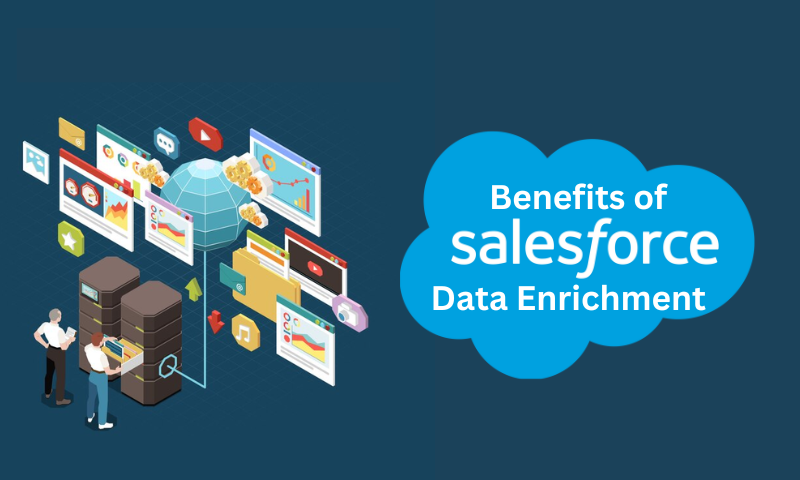Most companies use Salesforce as their preferred CRM system due to its unmatched features for managing customer data, automating workflows, and personalizing interactions. However, this robust system can only become fully operational when fed with up-to-date and accurate customer information. As sales teams today operate in an intensely competitive environment where they must meet targets and increase sales, incorrect or outdated customer data in their CRM systems can hinder the effectiveness of their sales strategies and processes. This is where Salesforce data enrichment becomes essential, providing your sales teams with additional and relevant information to better understand customers and generate high returns.
Read on to learn how an enriched understanding of your prospects and customers can empower your sales teams to optimize sales efficiency.
Table of Contents
Benefits of Salesforce Data Enrichment for Improving Sales Efficiency
1. Precise Targeting
Enriched data helps your sales teams better understand the ideal customer. Through newly added firmographic or technographic details, sales teams can identify high-value prospects who are more likely to convert. Analysis of this data helps you target the right leads who are genuinely interested in your products or services, ultimately driving more conversions and success of your sales strategies.
For instance, if you are a software company targeting enterprise clients, enriched data might reveal which companies are actively seeking new software solutions based on their recent technology investments and online interactions. You can then target your sales messages toward these companies promoting those services that closely resonate with their needs and solve their problems.
2. Reduced Administrative Burden
Salesforce data enrichment alleviates the administrative burden on your sales teams. Instead of wasting time verifying outdated information or searching for missing details, they can rely on the centralized data repository– the CRM system, to access accurate and up-to-date information. This can be achieved by scheduling regular data enrichment processes, where fresh information is automatically pulled from reliable sources. With minimal manual intervention, this critical information becomes readily available, increasing sales productivity.
For example, consider a situation where a sales representative needs to contact a potential client. A proper data enrichment process makes details like phone numbers, email addresses, and job titles readily available, eliminating the need for manual searching. Instead of gathering client details from various sources, the representative can focus on core sales activities, such as building a better relationship and closing the deal faster.
3. Streamlined Lead Prioritization
Salesforce data enrichment makes it easier and more efficient for your sales teams to identify and prioritize leads. By using enriched data to fill in missing information in your Salesforce database, you can quickly see which leads are more likely to become actual customers. This helps your sales team spend their time and effort on the leads that are most likely to result in successful sales, generating higher conversion rates and revenue.
For example, data enrichment might reveal that a prospect from a Fortune 500 company has downloaded your whitepaper and visited your pricing page multiple times. This behavior indicates a high level of interest and engagement with your offerings. Recognizing this, you can prioritize this lead, enabling your sales team to focus their efforts on this promising prospect and increasing the chances of conversion.
Tips to Implement Salesforce Data Enrichment for Optimizing Sales Efficiency
1. Conduct a CRM Data Audit
For your Salesforce data enrichment strategies to succeed, understanding the scope of enrichment needed is essential. Conduct a thorough analysis of your current database to find gaps, duplicate information, or incorrect entries. With this knowledge, you can prioritize which data fields require immediate attention and plan your data enrichment strategy accordingly.
2. Integrate Reliable External Data Sources
Add external data sources to your Salesforce CRM to enrich your data. You can integrate LinkedIn Sales Navigator to access and enrich professional contact information or job titles relevant to your industry or business. Moreover, platforms like ZoomInfo provide up-to-date company and contact data, helping you convert potential customers before your competitors do.
3. Leverage AI and Machine Learning
Analyze and enrich your Salesforce data with the help of AI and machine learning algorithms to generate valuable insights for better sales strategies. From learning patterns in existing data to predicting customer behavior based on past performance, AI and ML have stepped up business operations more than ever. For instance, you can automate detecting missing data or inconsistent patterns with AI-powered solutions. Machine learning, on the other hand, can keep learning from these new inputs and update existing records in Salesforce for consistent data enrichment. This ensures your data stays relevant and up-to-date as per the latest industry trends.
4. Implement Real-Time Data Enrichment
You can also utilize tools like Clearbit or ZoomInfo for real-time data enrichment to keep your Salesforce CRM updated with the latest information. These tools automatically update client details in Salesforce whenever there’s a change in their information. This improves overall sales operations agility, allowing your sales representatives to act promptly on new data and emerging opportunities.
5. Partner with Experienced Service Providers
Appending your Salesforce data in-house can be challenging due to factors such as access to limited data enrichment tools and techniques, lack of technical expertise, and the time-consuming nature of the process. Outsourcing data enrichment tasks can provide significant benefits. For example, a leading US-based water technology company recently partnered with an external service provider and experienced a 52% increase in sales due to clean and accurate data. They had a database of 500,000 existing customers and prospects, but their CRM contained outdated and incomplete information, leading to wasted marketing efforts and slow sales. The external provider helped to refresh and enrich their data, resulting in more efficient and effective sales processes.
To Conclude
Data enrichment is far more than just a process – it’s an important growth strategy for businesses today. As the marketplace is getting increasingly competitive, the ability to swiftly adapt and cater to customer needs through the analysis of enriched data will be a critical differentiator. Looking ahead, it’s crystal clear that the need for Salesforce data enrichment will continue to evolve. Companies that prioritize effective data enrichment practices and make it a core focus will be well-positioned to outperform their competitor’s sales strategies. Organizations that prioritize the development of this capability will emerge as leaders, driving innovation and achieving sustained growth that surpasses their competitors.













Better fivem combat V2
June 8, 2024Course Connect
June 8, 2024Using perfect strategy for sales and leads is very important and also unique depending on particular business. And you explained it really well.